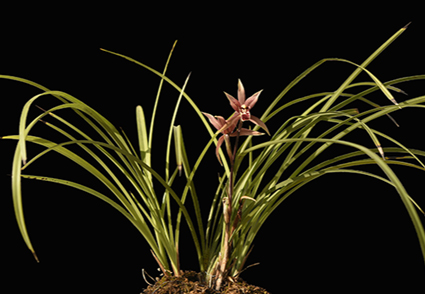Abstract
A new orchid species, Cymbidium purpureisepalum, from Yunnan Province, China, is described and illustrated based on morphological and molecular analyses. Detailed comparison of the newly discovered orchid with other members of Cymbidium indicated the new orchid is distinct from all other recognised species in Cymbidium. Molecular analyses based on nuclear (nrITS) and plastid DNA (matK) sequence data also support the status of C. purpureisepalum as a new species, which is sister to C. tortisepalum and C. serratum.
References
Chen, G.Z., Huang, J., Zhang, G.Q., Ma, L. & Chen, S.P. (2017) New subtribe Pachitinae (Orchideae) of Orchidaceae: evidence from morphological and molecular analyses. Phytotaxa 329: 114–126. https://doi.org/10.11646/phytotaxa.329.2.2
Chen, S.C., Liu, Z.J., Zhu, G.H., Lang, K.Y., Ji, Z.H., Luo, Y.B., Jin, X.H., Cribb, P.J., Wood, J.J., Gale, S.W., Ormerod, P., Vermeulen, J.J., Wood, H.P., Clayton, D. & Bell, A. (2009) Orchidaceae. In: Wu, Z.Y., Raven, P.H. & Hong, D. (Eds.) Flora of China, vol. 25. Science Press, Beijing & Missouri Botanical Garden Press, St. Louis, pp. 260–280.
Du Puy, D.J. & Cribb, P.J. (2007) The genus Cymbidium. Royal Botanic Gardens, Kew, Richmond, 359 pp.
Freudenstein, J.V. & Rasmussen, F.N. (1999) What does morphology tell us about orchid relationships?—A cladistic analysis. American Journal of Botany 86: 225–248.
Fukuyama, N. (1934) Studia orchidacearum Japonicarum I. Botanical Magazine (Tokyo) 48: 297–308.
Hu, W.Q., Zhang, Q.H., Chen, G.Z., Zhu, M.J., Yu, X., Zhang, D.Y. & Liu, Z.J. (2021) Cymbidium motuoense (Orchidaceae; Epidendroideae), a new species from China: evidence from morphological and molecular data. Phytotaxa 509: 106–112. https://doi.org/10.11646/phytotaxa.509.1.5
Huang, M., Liu, Z., Yang, G. & Yin, J. (2017) An unusual new epiphytic species of Cymbidium (Orchidaceae: Epidendroideae) from Hainan, China. Phytotaxa 314: 289. https://doi.org/10.11646/phytotaxa.314.2.12
Hunt, P.F. (1970) Notes on Asiatic orchids 5. Kew Bulletin 24: 93–94. https://doi.org/10.2307/4103252
Jiang, Y.T., Ma, L., Lin, R.Q., Xiong, Y.F., Jiang, S.Z., Liu, B., Liu, Z.J. & Chen, S.P. (2020) Cymbidium codonanthum (Orchidaceae; Epidendroideae; Cymbidiinae), a new species from China: evidence from morphological and molecular analyses. Phytotaxa 453: 275–283. https://doi.org/10.11646/phytotaxa.453.3.9
Liao, X.Y., Liu, X.D., Jiang, Y.T., Zhang, D.Y., Lan, S.R. & Liu, Z.J. (2019) Cymbidium atrolabium (Orchidaceae; Epidendroideae), a new species from China: evidence from morphological and molecular data. Phytotaxa 423: 87–92. https://doi.org/10.11646/phytotaxa.423.3.4
Liu, Z.J., Chen, S.C. & Ru, Z.Z. (2006) The genus Cymbidium in China. Science Press, Beijing, 237 pp.
Miller, M.A., Pfeiffer, W. & Schwartz, T. (2010) Creating the CIPRES Science Gateway for inference of large phylogenetic trees. In: 2010 Gateway Computing Environments Workshop (GCE). pp. 1–8.
Peng, Y.L., Zhou, Z., Lan, S.R. & Liu, Z.J. (2019) Cymbidium jiangchengense (Orchidaceae; Epidendroideae; Cymbidiinae), a new species from China: evidence from morphology and DNA sequences. Phytotaxa 408: 77–84. https://doi.org/10.11646/phytotaxa.408.1.6
Ronquist, F. & Huelsenbeck, J. (2003) Mrbayes 3: Bayesian phylogenetic inference under mixed models. Bioinformatics 19: 1572–1574. https://doi.org/10.1093/bioinformatics/btg180
Schlechter, F.R.R. (1919) Orchidologiae Sino-Japonicae Prodromus. Repertorium Specierum Novarum Regina Vegetabilis, Beihefte 4: 73–74.
Schlechter, R. (1924) Die Gattungen Cymbidium Sw. und Cyperorchis Bl. Repertorium Novarum Specierum Regni Vegetabilis 20: 96–110. https://doi.org/10.1002/fedr.19240200605
Seth, C.J. & Cribb, P.J. (1984) A reassessment of the sectional limits in the genus Cymbidium Swartz. In: Arditti, J. (Ed.) Orchid biology: reviews and perspectives III. Comstock, Ithaca, pp. 283–332.
Sharma, S.K., Kumaria, S., Tandon, P. & Satyawada, R.R. (2012) Comparative karyomorphological study of some Indian Cymbidium Swartz, 1799 (Cymbidieae, Orchidaceae). Comparative Cytogenetics 6: 453.
Singer, R.B., Gravendeel, B., Cross, H. & Ramirez, S.R. (2008) The use of orchid pollinia or pollinaria for taxonomic identification. Selbyana: 6–19.
Sun, Y., Chen, G.Z., Huang, J., Liu, D.K., Xue, F., Chen, X.L., Chen, S.Q., Liu, C.G., Liu, H., Ma, H., Yuan, Y., Zhang, D., Sun, W.H., Peng, D.H., Wang, Z.W., Lan, S., Zhao, G.Q., Li, F.T. & Liu, Z.J. (2021) The Cymbidium goeringii genome provides insight into organ development and adaptive evolution in orchids. Ornamental Plant Research 1: 1–13. https://doi.org/10.48130/OPR-2021-0010
Swartz, O. (1799) Dionome epidendri generis Linn. Nova Acta Regiae Societatis Scientiarum Upsaliensis 6: 61–88.
Swofford, D.L. (2002) PAUP*: Phylogenetic analysis using parsimony (*and other methods). Version 4.0b10. Sinauer Associates, Massachusetts.
Xu, X.Y., Ding, C.C., Hu, W.Q., Yu, X., Zheng, Y., Zhang, D.Y., Liao, X.Y., Liu, X.D., Liu, Z.J. & Lan, S.R. (2021) Cymbidium xichouense (Orchidaceae; Epidendroideae), a new species from China: evidence from morphological and molecular data. Phytotaxa 484: 291–297. https://doi.org/10.11646/phytotaxa.484.3.4
Yang, F.X., Gao, J., Wei, Y.L., Ren, R., Zhang, G.Q., Lu, C.Q., Jin, J.P., Ai, Y., Wang, Y.Q., Chen, L.J., Ahmad, S., Zhang, D.Y., Sun, W.H., Tsai, W.C., Liu, Z.J. & Zhu, G.F. (2021) The genome of Cymbidium sinense revealed the evolution of orchid traits. Plant Biotechnology Journal 19: 2501–2516. https://doi.org/10.1111/pbi.13676
Yu, X., Zeng, M.Y., Chen, G.Z., Xu, X.Y., Bi, Y.Y., Chen, J.T., Wang, Q.Q., Hu, W.Q., Zhang, D.Y. & Liu, Z.J. (2021) Cymbidium weishanense (Orchidaceae; Epidendroideae), a new species from China: evidence from morphological and molecular data. Phytotaxa 500: 45–50. https://doi.org/10.11646/phytotaxa.500.1.6
Zhang, D.Y., Tu, X.D., Liu, B.I.N., Liao, X.Y., Lan, S.R. & Liu, Z.J. (2020) Cymbidium biflorens (Orchidaceae; Epidendroideae), a new species from China: evidence from morphological and molecular data. Phytotaxa 428: 271–278. https://doi.org/10.11646/phytotaxa.428.3.8
Zhang, G.Q., Chen, G.Z., Chen, L.J., Zhai, J.W., Huang, J., Wu, X.Y., Li, M.H., Peng, D.H., Rao, W.H., Liu, Z.J. & Lan, S.R. (2021) Phylogenetic incongruence in Cymbidium orchids. Plant Diversity 43: 452–461. https://doi.org/10.1016/j.pld.2021.08.002
Zhou, Z., Zhang, D., Chen, G.Z., Yu, X., Li, C.R., Lan, S.R. & Liu, Z.J. (2020) Cymbidium brevifolium (Orchidaceae; Epidendroideae), a new species from China: evidence from morphological and molecular data. Phytotaxa 464: 236–242. https://doi.org/10.11646/phytotaxa.464.3.5


